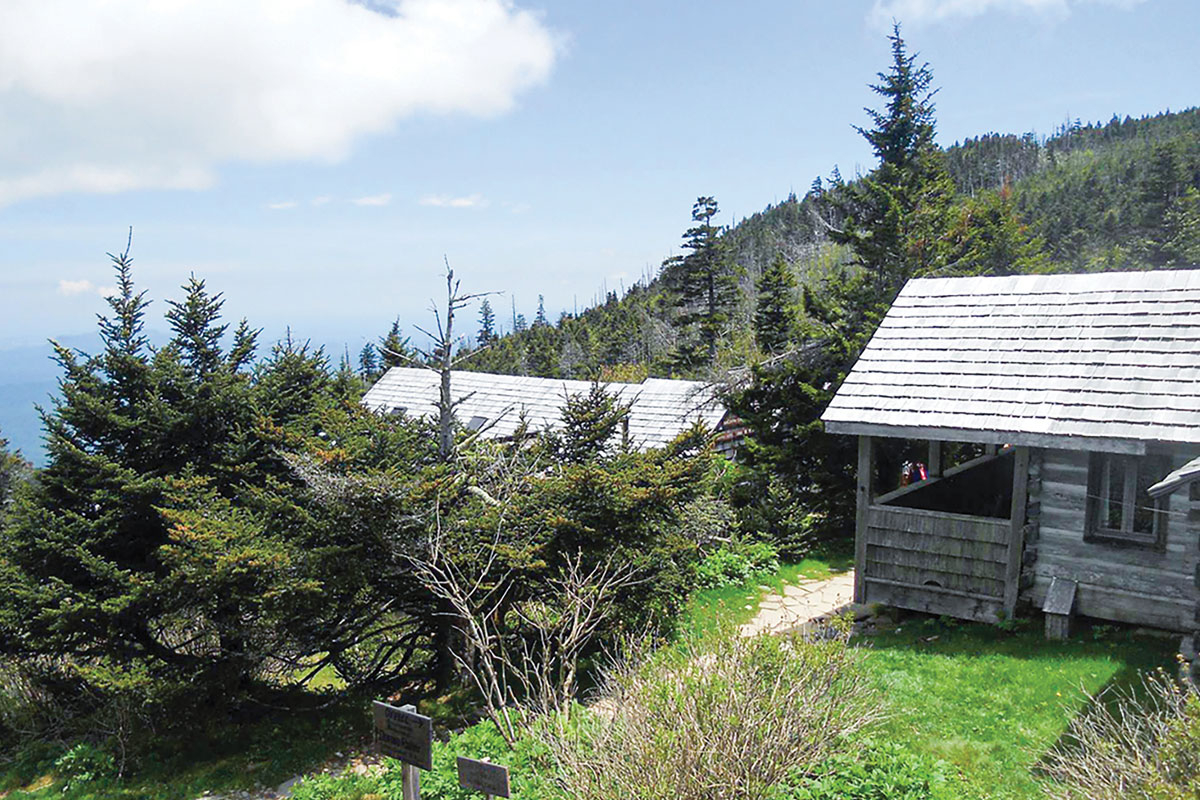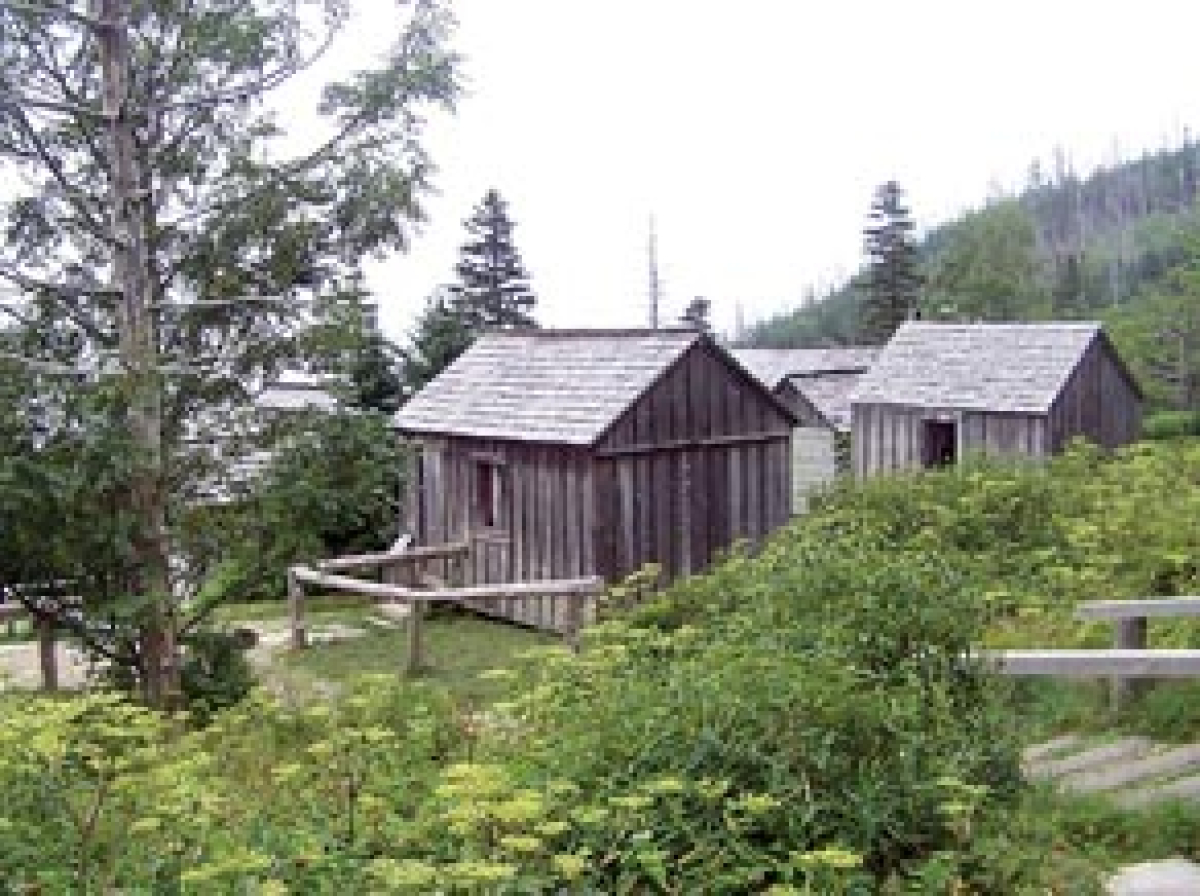Resurrecting Balsam Mountain Preserve is one part business, two parts passion
New owners of the high-end Balsam Mountain Preserve development aren’t daunted by the choppy waters of Western North Carolina’s real estate landscape.
Despite the still tepid demand for pricey second homes in the mountains, they say they have charted a course that will bring the beleaguered development out on the other side of the storm still raging across the rest of the region.
The 4,400-acre mega-development — one of the region’s few mountainside golf developments that can rightfully carry that tag line — has its share of battle scars. It’s been through foreclosure, repossessed by investors, hawked to the lowest bidder, babysat by an out-of-state caretaker, then put up for sale.
Now, a rescue of Balsam Mountain Preserve has come full circle. Two wealthy homeowners in the development teamed up to buy the development for $6 million — a fraction of what it was once worth.
If there’s ever a development where millionaire homeowners could emerge from the ranks to become the owners, it’s Balsam Mountain Preserve. Harry Avant of Louisiana and David Carlile of Texas knew each other previously from the oil and gas industry, even before buying their respective property in Balsam Mountain Preserve several years ago.
They have hired two former members of the Balsam sales team to come back and run the place. Jimmy McDonnell and Bruce Fine both worked together at Balsam Mountain Preserve under the original owners and developers.
“We know the owners, we know the property, we know the employees, we know the project, we know the market,” Fine said of their return, this time as president and vice president.
The hunt for solid ground in today’s new real estate landscape is more than just a financial deal for the new team.
“If there wasn’t a significant upside from a financial and business perspective we probably wouldn’t have done it. These guys are not a nonprofit entity,” Fine said. “But to save a place that you really have an emotional connection to, and it could be a good business decision at the same time, is a win-win overall.”
For the past 18 months, Balsam Mountain Preserve has been in limbo. The former owners defaulted on $19 million in debt and went into in foreclosure. The development landed in the hands of a private equity firm that immediately began looking to unload it.
So what, exactly, did Avant and Carlile get for their $6 million purchase of Balsam Mountain Preserve?
For starters, they own a really, really nice Arnold Palmer golf course. All the amenities, from the swimming pool to tennis courts to clubhouse to riding stables, are also included.
But as for what’s marketable — the pieces of the development that are worth something — there are about 130 to 150 home sites left to sell off.
Only one lot has sold in Balsam Mountain Preserve this year, however.
“2011 was kind of a lost year for Balsam. It was for sale and people knew it was for sale,” Fine said.
Despite the unimpressive showing, the new team isn’t fretting over whether Balsam Mountain Preserve will make it. Optimism over the new owners is already fueling sales, Fine said. There are two contracts pending — one on a new lot and one on an existing lot being resold by a property owner.
“We have more activity in the week we have owned this place than we’d had all year,” Fine said early last month. “People are moving forward now because it is stable. They like the story about the homeowners who have joined together and bought the place.”
Few golf course developments can claim to have that bumpy road behind them.
“Every other one has the loom of foreclosure and takeover,” McDonnell said.
Fine said few are going to emerge as intact as Balsam.
“There are so many communities in the mountains that have nothing there other than a front entrance and some renderings on paper. Those are the places that have fallen off the end of the earth,” Fine said.
At Balsam Mountain Preserve, there is enough “critical mass” already in play, Fine said. The golf course is finished, the swimming pool has water, a restaurant and clubhouse are functioning. Roads actually lead to the lots — a novelty compared to some subdivisions that lack even that bare essential.
Most importantly, though, are the 70 homes on the ground and another 110 property owners of lots. Too many subdivisions in the mountains are empty ghost towns, and just like no one wants to eat in an empty restaurant, no one wants to be the first to build — not when it’s such a buyer’s market. And that’s why homes on the ground are an important part of Balsam’s critical mass.
Nowhere to go but up
As the rest of the nation plunged into a recession in 2008, WNC seemed insulated from the real estate crash — its quality of life, desirable views and retirement reputation helped it hang on.
But by the end of that year, the economy finally caught up with the region — and with Balsam Mountain Preserve. Lot sales simply evaporated.
With no cash coming in, the former developers Chaffin and Light, a highly reputable company known for massive eco-developments from South Carolina’s coast to Colorado, defaulted on its $19 million loan.
Chaffin had bargained hard for a work out, hoping to get an extension or refinance on the outstanding debt. Meanwhile, property owners at Balsam made a bid to save their own development from foreclosure. They raised $8 million and explored forming their own LLC to bail out Balsam Mountain Preserve and own the development themselves.
But the private equity firm, TriLyn, was unwilling to negotiate for anything less than a full payoff of the $19 million owed.
Marc Antoncic, the managing partner of the firm, arguably was in a tough spot. He was supposed to be earning investors a return on their money — not losing their money. So he had a choice. Cut his losses, take what he could get and get out — even if it meant selling Balsam at a rather substantial loss.
His other choice was to step in to the developer’s shoes himself, hoping to turn it around.
“You can’t rescue everything, but you can’t just sit back and hope it goes away,” Antoncic said in an interview 18 months ago, shortly after his take over. “If you bail today, you lose all that. We would turn over a good asset to someone else.”
In hindsight, it now seems he made the wrong choice.
He didn’t turn it around, and only got $6 million for the development in the end.
“Literally every deal they had on the table, whether it was Jim Chaffin or the homeowners, everyone of those was better than what they ultimately got,” Fine said.
“They had some great opportunities in front of them they chose not to take,” McDonnell agreed.
Homeowners, for their part, are optimistic for the first time since 2009 when Balsam Mountains Preserve headed down the path to foreclosure.
“Ever since then Balsam has been in a real state of uncertainty,” Fine said.
What would happen to the golf course had been one of their biggest fears. Well-groomed fairways with that perfect phosphorescent green hue come at a steep price. The golf course had been losing $1 million a year. The original developers, Chaffin and Light, were underwriting the cost of the golf course operations. Picking up that price tag is part of what sunk the developers.
After foreclosure, homeowners had to pony up the money to operate the course.
A new model
There are only a handful of developments in WNC in the same league as Balsam Mountain Preserve: of a similar acreage, prestige, price range and quality. And they too are seeing a comeback, suggesting the market has at long last bottomed out, Fine said.
“Prices are lower compared to where they were at in 2006, but they are coming back,” Fine said. “It sounds cliché-ish, but for someone who wants to be here this is when people want to strike. We aren’t at the bottom anymore.”
That financial strategy is part of Fine’s sales pitch. But the other part is far more emotional.
“The person who is waiting for the bottom is putting off living their life,” Fine said.
Indeed, the pent-up demand is why Fine has such a rosy outlook for 2012.
“The dynamic is people have put their plans on hold for anywhere from three to four years,” Fine said. “I’ve been sitting on the sidelines, I’m not any younger, I’m not any healthier, my grandkids are getting older.”
And that reality could drastically change the real estate paradigm in WNC. Before, baby boomers looked for lots to build their dream home on. But building a house — from deciding on a layout for the master walk-in closet to choosing the color of granite for the kitchen counter — can take two to three years. These days, prospective buyers want to get on with it — and perhaps spare their marriage the strain of a custom-built house — even if it means they won’t be picking out their own light fixtures or tile floor design.
“People want something they can move into,” Fine said. “In conjunction with that dynamic, people are also no longer buying what they can afford, they are buying less than they can afford in a lot of cases.”
People used to buy at the upper end of their limit — assuming that real estate would always be worth more next year anyway. But with appreciation less of a sure bet these days, second-home buyers are rethinking.
“Seriously, do I need 6,000 square feet in retirement? That’s how affluent people are thinking today,” Fine said.
Which means Balsam Mountain Preserve must retool its model — as with the rest of WNC’s developers.
“It is not going to be all about 2-acre single family home sites,” Fine said. “If you sit around and wait for individual home site buyers to come visit you one at a time, it will be years and years and years before you sell through all your availability.”
What’s in Balsam Mountain Preserve’s cards now would have been borderline blasphemy several years ago: smaller lots, pre-built homes, and even perhaps townhomes.
“Balsam has never had that, ever,” Fine said.
There are about 35 lots in the current phase of the development already platted and ready to sell. Another 100 or so are in the works, and will like take the form of smaller, more closely spaced lots rather than larger, spread-out ones. And, they could be sold with homes already on them rather than empty lots.
As a development, Balsam Mountain Preserve doesn’t particularly want to get into the spec home business. Developers generally sell lots, builders build homes.
But that’s where Balsam Mountain Preserve once again hopes to tap its unique base of homeowners.
Homeowners, eager to see their own community succeed, may actually finance construction of model homes by a builder. The homeowner would theoretically be helping out the builder they used and liked when building their own home, make a little money and help land new neighbors to keep Balsam Mountain Preserve stable.
“The developers who can facilitate these alliances between people who can finance — i.e., non-banks — and the builders, those are the communities that are really going to thrive in this segment,” Fine said.
Bear shooting leads to a bevy of charges, from poaching to littering
Wildlife officers have charged a Cashiers man with killing a bear that he claimed was damaging his property, the second such case in Jackson County in less than a year.
Jeffrey Spencer Green, 39, was charged recently with illegally shooting and killing a 300-pound bear, according to records on file at the Jackson County Clerk of Court’s office. Green claimed the bear was damaging his house and property on Slab Town Road, but there was no evidence supporting that claim, Wildlife Officer Brent Hyatt said.
Last summer, Hyatt charged Sylva chiropractor John Caplinger with killing a bear perched in a tree on his property. Caplinger, like Green, reportedly claimed that he believed the bear a threat.
State law forbids killing a bear unless it’s causing significant property damage or is threatening a person’s life. Replacement costs for a bear are $2,213 in North Carolina. Court costs alone top $2,000. Combined convictions could carry hefty financial penalties.
Both Green and Caplinger, coincidentally, are set to appear in a Jackson County courtroom Jan. 26.
But, poaching a bear isn’t the only charge Green will face. As Hyatt traced the dead bear back to Green, it resulted in a slew of other charges against Green, plus two other Cashiers residents as well.
The investigation led to charges of an illegally killed deer and a turkey. There’s even a littering charge against Green for, according to Hyatt, improperly disposing of the turkey by tossing its carcass out of a vehicle window onto the roadside.
The bear beginning
According to court papers and Officer Hyatt, Green shot the bear a stone’s throw off N.C. 107 on Slab Town Road near the busy Cashiers’ crossroads. Upset by the death of this favorite neighborhood visitor, someone aware of and unhappy about the bear’s slaying tipped the state agency.
Hyatt said he suspects some of Slab Town’s residents were feeding the bear, causing it to lose its healthy, natural fear of humans. Though he’s sympathetic regarding the neighborhood’s loss, Hyatt said the situation served as yet another reminder to not feed wildlife — for the bear’s own good.
After shooting the bear, Green let it lie on the side of the road for a day, Hyatt said, then called a friend, Steve Crawford of the Pine Creek community, and asked for help moving it.
“The deal was Mr. Crawford would keep the meat, Mr. Green the bear hide,” Hyatt said, adding that the bear meat actually had spoiled because the animal was left in the heat for too long.
Crawford ended up being charged with possessing and transporting an illegally taken black bear.
As the investigation blossomed, Hyatt said he charged Green with, among a variety of other charges, night deer hunting and taking a turkey out of season.
Additionally, Marlena Carlton of Cashiers was charged in the night deer-hunting incident, Hyatt said.
“It turned into a big case,” the wildlife officer said in a bit of an understatement.
Report poaching
The N.C. Wildlife Resources Commission is actively seeking the public’s help. Call in wildlife violations for investigations at 800.662.7137 or, if in Jackson County, call Wildlife Officer Brent Hyatt directly at 828.293.3417.
Who will Haire’s heir be? State office holder’s retirement opens up race for House
N.C. Rep. Phil Haire’s decision not to run for re-election after 14 years in office opens the door for a possible free-for-all of both Democratic and Republican candidates seeking the suddenly available House seat.
Tuesday’s news spread like an out-of-control wildfire through Western North Carolina’s political grapevine. Top leaders in both parties will clearly be paying close attention to this now vacant seat — a seat Haire had easily secured year after year for the Democratic Party but could now be in flux.
“This is not a good sign for Democrats,” said Chris Cooper, a political science professor at Western Carolina University. Incumbent Democrats tend to hold on. But when their seats come open, then those seats are much more likely to go Republican.”
Taking control of Haire’s seat won’t be easy, however. Democrats outnumber Republicans in the district — which is made up of Waynesville and Lake Junaluska in Haywood County, Jackson County and Swain County.
But a possible pile-on by Democrat candidates could weakend their position going in to the general election in the fall, Cooper said.
“If they have too many eggs in a basket, they will shoot themselves in the foot. The best thing for the Democratic Party is to figure out who the best candidate really is,” Cooper said.
Any Democrat with state political aspirations might figure this could be their one shot at holding office. Haire had proved immovable from the seat until he opted to step down.
For his part, Haire said there’s not an “heir” apparent.
“I am not going to speculate because I am sure there are going to be several people in the primary,” the state representative said, adding that he won’t endorse anyone.
“I am not going out on that limb,” Haire said.
Haire plans to wait and see who wins the primary, then support that candidate in the general election. The Democrat’s primary winner had better be a strong candidate and be girded for a fight, Haire said.
“Since it is a vacant seat, the Republicans will make a shot at it,” Haire said. “I guarantee you Republicans will make a good strong effort to take it.”
It could be the GOP’s one shot, too. For Republican Party leaders, the news that a veteran incumbent Democrat would be retiring came as a belated, but happily received, Christmas present.
Ralph Slaughter, chairman of the Jackson County Republican Party, was clearly pleased with GOP prospects of seizing the district. During the last election, Haire had to fight off an unexpectedly strong attempt by Sylva Republican candidate Dodie Allen, giving Republicans added hope this time around.
Allen, a Sylva auctioneer, ran a grassroots campaign. She narrowly beat Haire in Haywood County and ended up garnering 44 percent of the vote district-wide.
One Republican candidate immediately emerged Tuesday following Haire’s announcement. Mike Clampitt of Bryson City said he’d run for the now-vacant seat.
“I believe that North Carolina is at a crossroads, and that we must bring conservative common-sense leadership to the state,” Clampitt said in a news release issued Tuesday.
But one veteran Republican struck a cautionary note on the prospect of wresting Haire’s vacated seat away from the Democrats.
“It is a good strong Democratic district,” said N.C. Rep. Roger West, R-Marble, who has served with Haire in Raleigh for more than a decade. West said bluntly that he doesn’t see Republicans being able to capture Haire’s seat given the district’s leanings.
In the Democratic field, one name being circulated is former Judge Danny Davis of Waynesville. Davis said that he’d barely had a chance to process the news Tuesday that Haire wouldn’t run before his phone started ringing from people wanting to know if he would.
“I am interested in it. I am not ready to commit just yet, but I am always interested in serving,” Davis said, adding that “Phil has done a great job and I hate to see him go.”
Davis said he had contemplated running for Haire’s seat whenever Haire retired — he just didn’t think it would be this soon.
N.C. Rep. Ray Rapp, D-Mars Hill, is probably one of the most observant watchers of the rapidly unfolding political changes in the far-western counties. Rapp’s legislative district borders Haire’s to the north. As neighboring representatives Rapp and Haire often worked together. This is a political necessity for getting anything accomplished for this slice of the state. After all, there are more state representatives from the Charlotte area alone than in all of WNC, from Murphy to Boone.
Rapp hopes that the winner of Haire’s vacated seat will be a go-to partner in the legislature, and for this reason, he isn’t about to support one candidate over another just yet.
“There are a number of qualified people who could step up and do a fine job of serving in the WNC legislature and I look forward to working with whomever the district chooses for its eventual representative,” Rapp said.
Long-time state legislator retires
N.C. Rep. Phil Haire, D-Sylva, will retire from the state legislature this year after 14 years in office.
Haire will be 76 next year and said that he realized it’s time to trade in the long drives back and forth to Raleigh for some quality time with his grandchildren.
“I am in great health and everything but you don’t want to push the edge of the envelope too hard,” Haire said, citing the 300-mile haul to Raleigh.
Plus, he really wants to go to Alaska.
“I have never been to Alaska. I could never go because the time to go is in the summer and I am always tied up in the summer,” Haire said.
Although Haire said he has known for some time that this would be his last year in Raleigh, he kept the news of his retirement surprisingly close to his vest. Besides him, only his wife knew, Haire said.
“I didn’t want to say anything until now. The cat is out of the bag today,” Haire said Tuesday morning.
SEE ALSO: Who will Haire's heir be?
After Haire made the announcement, word was spread primarily by newspaper reporters, who broke the news to everyone from political analysts to party leaders in the process of calling people to get their thoughts and comments.
Among those who learned this way was Rep. Ray Rapp, D-Mars Hill, who served closely in the legislature with Haire — both as fellow Democrats and as representatives of neighboring legislative districts. Rapp met the news with “a great deal of sadness.”
“I am surprised that Rep. Haire will not be returning to Raleigh and more than a little disappointed,” Rapp said. “I think he has brought a very sharp mind and has been a strong advocate for Western North Carolina over these 14 years. So I can tell you his knowledge and his experience will be sorrowfully missed.”
N.C. Rep. Roger West, R-Marble, served with Haire for 12 of his 14 years in office, representing the counties that neighbored Haire to the south.
Despite being from the opposing political party, West only had good things to say about Haire. They disagreed philosophically on issues at the state level, but when it came to local issues important to the mountains they nearly always worked together, West said.
“Haire was a good legislator. He looked after the people in his district. I enjoyed working with Phil. I can’t say anything bad about him at all. We’ll miss him,” West said.
The two even carpooled to Raleigh occasionally or caught a plane together in Asheville. And besides, Haire’s son is married to West’s niece.
Janie Benson, chairman of the Haywood County Democratic Party, said Haire would be hard to replace.
“I think Phil has represented his district well, and stayed in touch with the people,” Benson said.
Looking back at 14 years of state office, Haire said one of his crowning accomplishments was the Safe Surrender Law, which allows a mother of a newborn baby to turn it over to a responsible party, such as a hospital or police department, and walk away without penalty. Haire fought for the law after a young mother in his district placed her newborn baby in a trashcan. The baby died and the mother went to jail. Haire realized a bill was needed making it legal to safely surrender the newborn without a parent being punished for abandonment.
Haire was also one of the leading advocates of the Clean Smokestacks Acts, and consistently received high rankings from conservation groups for his pro-environment voting record.
But it’s the little things that truly defined Haire’s career, the incremental measures he fought for every day, from funding for the N.C. Center for the Advancement of Teaching in Cullowhee to a highway appropriation for a second entrance to Tuscola High School.
“He’s been really dedicated about working hard for this area,” said former N.C. Sen. John Snow of Murphy, Haire’s counterpart in the state Senate for several years. “He dedicated 14 years to public service, and that’s no small thing.”
Numbers tell the tale: New Jackson library a self-fulfilling prophecy
The number of people applying for library cards in Jackson County has doubled since the new library opened this summer.
Jackson’s striking increase in library use in part is a testament to just how low use was before. A dismally undersized library, limited programs and a small collection led to abnormally low per capita use at its former location. In fact, Jackson had the lowest circulation per capita and fewer library card holders per capita compared to surrounding counties — and was well under the state average in those benchmark areas.
When planning for a new library began in earnest four years ago, librarians cautioned the county not to put too much stock in the number of past library users as a yardstick for how big the future library should be. New libraries are like self-fulfilling prophecies, with more users suddenly crawling out of the woodworks as soon as its doors open.
So while it’s no surprise that library use has gone up, no one anticipated it would go up by as much as it has.
Jackson’s has gone up by much more than other counties that have recently built new libraries.
• After building new libraries, Macon County saw only a 15 percent increase in the number of people applying for new library cards, Polk saw 12 percent increase and Transylvania County saw 58 percent — nothing close to the 100 percent increase in Jackson.
• Jackson’s new library has increased by 38 percent in circulation of materials. Compared to Macon’s circulation increase of 17 percent, Transylvania’s by 27 percent and Polk’s by 20 percent.
And, with 28 public computers, computer use is up an amazing 154 percent.
A counter on the front door is also logging a huge increase in the number of library visits. For that stat, Jackson County Head Librarian Dottie Brunette said that it isn’t just people living in Jackson County driving the higher numbers, however, though they obviously are beating a track into the library.
“Daily, we get people in just to look at it,” Brunette said.
Insanely popular
The new Jackson County library in Sylva has seen skyrocketing use since it opened this summer. These numbers tell the tale, comparing use between July and November of this year at the new library compared to the same five months of last year in the old library.
Old New
Items checked out 34,735 48,112
Computer sessions 5,501 14,196
Special programs 78 382
New Sylva library top in the state
Everyone who has seen and toured Jackson County’s new public library knows that it’s beautiful, but now the state has put an official stamp on that fact.
The library recently won the Outstanding Facility Award for new libraries larger than 26,000 square feet presented by the N.C. Public Libraries Directors Association.
Library patrons last week said they weren’t the least surprised to hear the facility was a state winner when it comes to beauty, functionality and technology.
“I love this library,” said Karen Wall, who was working on her laptop in the reference section one day last week. She was seated in a comfortable chair at a desk near huge windows affording a bird’s eye view of the Plott-Balsams mountain range.
SEE ALSO: New Jackson library a self-fulfilling prophecy
Wall described herself as a grateful library user. She is a voracious reader, one of those people who have two or more books going at a time. Fiction, nonfiction, it matters not just so long as the books involved are captivating.
“There’s a joy for me to be able to come here,” Wall said, gesturing toward the view.
That sentiment holds true for Becky Foxx of Sylva, too. Foxx’s one complaint is that the books aren’t as clearly labeled, by topics, as they were in the old library on Main Street. She was searching near the audio section for spiritual and self-help books, which were located several shelves from where Foxx actually was hunting. With 5,500 linear feet of shelving capacity — over one-mile of shelving if stretched out end to end — Foxx was finding navigation at the new county library a bit of a challenge.
That one irritant aside, Foxx loves her library. Like Wall, she said it was well worth every penny spent despite some grumbling over the price tag in certain quarters.
Jackson County’s library towers over Sylva — 107 steps up from Main Street — attached to the back of the historic courthouse complex. The new library cost $8 million, a project that also included renovating the historic courthouse as an auditorium and community meeting space.
The Jackson County Friends of the Library raised $1.8 million to outfit and furnish the new library. The cost per square foot was $282, including construction, landscaping, site improvements, architect and consultant fees and the furniture and equipment.
The librarian accept the facilities award last month in Greensboro where she presented a PowerPoint slideshow about the building at a showcase of the state awards given for facilities, programs, staff development and service innovation.
McMillan, Pazdan, Smith Architecture designed the library for Jackson County.
If there’s been one major challenge for Jackson County’s new library, it’s been parking. There just isn’t enough space on the 2.8-acre site, at least close-by, to meet demand.
There are only 73 parking spaces on top of the hill. To save those spots for library visitors, employees park in a lot down below and hoof it up the hill either from a small parking lot on Keener Street or from Mark Watson Park. The county recently improved a trail up leading the back side of the hill from Mark Watson Park and added a handrail to make the route more friendly.
Learning the craft
In a classic case of the student becoming the teacher, Brock Martin signed up for his first blacksmithing class at the Jackson County Green Energy Park and began apprenticing soon after.
That was four years ago.
Now, he has been teaching classes at the park for a little more than year.
“I was always interested in it,” Martin said.
However, he did not quite know how to get started or if anyone really lived as a blacksmith anymore. After a high school teacher introduced him to a group of medieval re-enactors, he began seeking out more information about the art.
Martin, 23, blacksmiths as often as he can, teaching classes or creating custom pieces for sale. A resident of Hickory, near Asheville, he makes maille jewelry and armor, among other things.
Creating something from metal can be a long process.
Students start with a metal rod, which they regularly heat to up to 2,300˚F.
The progression of the heat turns the metal from yellow to dark brown to blue to black to red.
“Once it gets red, you can really start getting it to do what you want it to do,” said Martin.
Then, they begin working the metal with all variety of hammers — ones with flat, square heads, ones with spherical heads and ones with wedges heads. Each makes a different impression on the metal, works it in a different way and can be used to make a myriad of objects. It all hinges on the angle of the metal versus the angle of the hammer’s blow.
“It’s a misconception that you have to be strong,” Martin said.
Depending on the project, shaping and perfecting an inch-long piece of metal can take more than an hour. The rod must be reheated to make it more malleable, but students must watch that thinner portions don’t get too hot. Steel begins to melt at 2,500˚F.
To temper the heat, they must immerse the thin and more easily warmed part of the rod in water so they can continue to heat thicker portions of it.
Beginning blacksmithing classes are offered about once a month at the Jackson County Green Energy Park. The park is part of a county government initiative to use the old Dillsboro landfill gases as well as promote sustainability and various educational opportunities.
The beginner classes are “very gradual” compared to the intermediate level, Martin said.
Students move from station to station, trying to master individual skills before they tackle the end goal of actually creating something.
The class sizes are generally small, making them more hands on. At a recent intermediate class, three people independently worked on projects as Martin moved from workstation to workstation, offering help and tips.
Although the class was only their first or second attempt, the three burgeoning blacksmiths have all spent time working with their hands.
Todd Sagy, 48, diligently worked on a metal toilet paper holder. As a welder, metal work is second nature, but blacksmith permits more creativity.
Blacksmithing allows him to “take something that’s nothing and make something out of it,” Sagy said.
There is a fine line between working the metal too much and not enough, said Jesse Johnson, a 22-year-old construction worker.
Johnson spent much of his time twisting the small steel rods, with which he worked, to craft a necklace holder for his girl friend’s birthday.
“It’s not that bad, really, if you are used to working with tools,” Johnson said. “Mostly, it’s just a lot of fun.”
After taking his first class, Jesse got his twin brother Josh to join in as well. Both said they had been interested in learning to blacksmith for a while but actually decided to take a class after their mother took a glassblowing class at the energy park.
Tug-of-war heats up over highway sign pointing to Cherokee
Counties and towns in the region are sparring over a highway sign that points the way to Cherokee, each hoping to capture a share of the 3.5 million annual visitors en route to the tribe’s casino by bringing that traffic past their own doorstep.
There are two routes to Cherokee — something any tourist could figure out using the Internet or an in-car GPS unit. However, only one route has a highway directional sign pointing the way to Cherokee, namely the route through Maggie Valley.
Jackson County officials are urging the North Carolina Department of Transportation to post a second highway sign letting travelers know they don’t have to get off the highway and head through Maggie but can continue on past Waynesville and Sylva to reach Cherokee as well.
Jackson sees itself as the big winner from such a sign but has appealed to Waynesville to join it in its request.
“We thought Waynesville might also be the beneficiary of that (sign),” said Jackson County Manager Chuck Wooten.
Currently, Cherokee-bound tourists coming off Interstate 40 are funneled toward Maggie on U.S. 19 just before they get to Waynesville.
Waynesville leaders discussed the issue at their town board meeting last week but postponed a decision until next year.
Neither Town Manager Lee Galloway nor Mayor Gavin Brown had spoken with officials in Maggie Valley about their take on the matter. However, at least one board member is against siding with Jackson County over Maggie Valley.
“I don’t feel like we should go against our own,” said board member Gary Caldwell.
As for Maggie Valley, officials said they had not heard about or had only heard tell of the possible signage.
Tim Barth, Maggie Valley’s town manager, said he was not aware that Jackson County had reached out to Waynesville looking for support. However, he said he would oppose such a sign.
“We would prefer that they come through Maggie Valley,” Barth said.
If the sign was erected, Maggie Valley would likely see fewer people driving down its main drag – which could further harm tourist businesses that are already struggling.
“Obviously, less people would be coming through the town then, and we depend on people coming through the town,” Barth said.
People traveling to Cherokee sometimes stop at restaurants or stores along the way, which is the main reason why Jackson County wants the sign — to cash in on some of those travelers’ checks.
“Our whole goal was to increase traffic (to the county),” Wooten said.
Which way?
For leaders in Cherokee and within the Eastern Band, having two routes to the reservation is about keeping customers happy.
“It’s important for our customers to have a choice,” said Robert Jumper, the tribe’s travel and tourism manager. “We want people to be able to come, in their most comfortable way, to Cherokee.”
If visitors are not happy with a particular route, they might not come back, said Jumper, who expressed support for the sign. He added that the additional route, which runs past Waynesville, would benefit both Haywood and Jackson counties.
When people call the Cherokee visitor center, they are directed through Maggie Valley or Jackson County based on their driving preferences.
Although vehicles traverse fewer road miles on the route through Maggie Valley, the low speed limits and a windy, two-lane road makes the scenic drive longer than expected, including a rather lengthy dead zone for cell phone users.
“The most direct route, of course, is through Maggie,” said Teresa Smith, head of the Maggie Valley Chamber of Commerce. “Obviously, it’s a straight shot (to Cherokee), and a majority of our businesses are on this main thoroughfare.”
However, the Great Smoky Mountain Expressway through Jackson County is generally the quickest route, a divided-highway with a faster flow of traffic, but drivers miss out on the views when going over Soco Gap in Maggie.
Jackson County has applied for a similar sign in the past, but nothing happened.
While the DOT has indicated that it would be possible to place a second sign near the existing one at Exit 103 on the by-pass, it is still unknown whether it will actually happen, Wooten said.
Hoping to sway the transportation department, the county has applied to others for support. Representatives from Cherokee and the Eastern Band of Cherokee Indians have signed their names to letters that indicate their support for the new sign.
“We feel that giving the motoring public an additional option of four-lane travel will provide better flow of traffic and enhance safety on both routes to Cherokee,” reads the letter signed by Jumper; Michell Hicks, principal chief of the Eastern Band; Jason Lambert, the tribe’s executive director of economic development; and Matthew Pegg, executive director of the Cherokee Chamber of Commerce.
The letter also states that the route through Jackson County provides drivers with a “direct, unimpeded” road to Cherokee.
A similar letter written by Jack Debnam, Chairman of the Jackson County commission, states that the expressway route offers an alternative that is easy for any type of vehicle to travel, during any type of weather.
Smith admitted that ice and snow have made the trip over Soco Gap hazardous on occasion but said that the road is nowhere near impassable.
“Vehicles have traveled it for years,” Smith said. “It’s not like it’s impossible. It’s not like it’s dangerous.”
Lynn Collins, executive director of the Haywood County Tourism Development Authority, declined to comment on the topic until she could meet with other members of the tourism board.
Tom Sawyer’s Tree Farm: A slice of Christmas with your choose-and-cut experience
Christmas tree farming is nothing new in Western North Carolina thanks to the perfect climate, perfect soil and preponderance of mountainsides — terrain that leaves farmers with few options for cultivating crops suited to slopes. Tree farms run the gamut, from a dirt farmer plunking down a half-acre of trees on the hill behind his house to massive wholesale tree dealers with thousands of acres in production.
Tom and Myra Sawyer of the Glenville community in southern Jackson County, however, have taken the traditional WNC Christmas tree farm and turned that concept on its ear. The Sawyers transformed their chose-and-cut tree farm into a little slice of the North Pole, complete with a visiting Santa and a cadre of elves.
In doing so, the couple has tapped into the growing agri-tourism niche. Plus they’ve provided scores of their Glenville and Cashiers neighbors with sorely needed seasonal employment. Up to 50 people work on the farm this time of year — not counting those employed through their wreath-making shop, year-round tree farm operation and the four retail Christmas tree lots they operate in Florida, Tennessee and Georgia. It also doesn’t take into account the large number of family members Tom and Myra Sawyer also provide jobs for. Or the burgeoning wedding-destination sideline they’ve recently started.
Tom Sawyer, in a quiet way in a remote section of the region, is putting a whole lot of folks to work.
Elves abound in Glenville
Tom Sawyer’s Christmas Tree Farm & Elf Village is simply not like anything else you find in the region. There are Christmas trees for the choosing, a Christmas-themed shop, rides on horse-drawn wagons, an elf village and a whole lot of “elves.” Thousands of people make the curvy, challenging drive here each season, Sawyer said, from as far away as Atlanta and Upstate South Carolina.
The story, as Tom Sawyer relates it, is that Santa Claus sometime in the 1940s crashed his sleigh in Glenville. The elves opted to stay in this location, hence the elf village that resulted. (It wasn’t clear how this many elves — scores of them, in fact — could have squeezed onto that small sleigh with Santa, but facts shouldn’t stand in the way of a good story.)
There is a small elf chapel, an elf outhouse, an elf naughty-time out-hut and much, much more. Once Sawyer, a former certified public accountant from Florida who started growing trees here in 1982, gets an idea you’d better watch out. Because what he conceptualizes he makes happen.
The youngest child of older parents, Sawyer said that in many ways he grew up more as a little adult than an actual kid.
“I guess I’m now reliving my childhood somehow that I never had,” Sawyer said, gesturing toward the elf village.
From the looks of it, the entire community is doing the same. Take Debra Adams, dressed in her elf costume greeting people as they arrive at the farm. Adams’ two nieces also work at Sawyer’s Christmas extravaganza, one doing face painting, the other storytelling.
Adams is a professional photographer who made the move here from Mississippi to be with her sister and nieces.
“I came up, and decided to move the business here,” Adams said. “In the meantime, this is really helping pay for Christmas. (The Sawyers) have really helped with jobs in this area during these slow periods.”
That makes Sawyer very happy.
“We’ve been able to put a lot of people to work,” Sawyer said. “It’s pretty amazing. Especially in this recession, it brings tears to your eyes the people who call and need jobs — there’s just no economy here this time of year.”
Until recently, Sawyer kept a herd of reindeer on the farm. For a variety of natural reasons, he said, the herd dwindled out. Sawyer wants to restart the reindeer portion of his business, but a state quarantine on importing the animal has prevented that from happening to date.
Reindeer didn’t just attract additional visitors. A few years ago, Sawyer took a cell call from his daughter, who reported a really huge animal was hanging out on the 80-acre farm. It turned out that one of the reintroduced elk from the Great Smoky Mountains National Park had made its way from Cataloochee Valley in Haywood County all the way to Glenville. Apparently missing the camaraderie of fellow hoofed beasts during its wanderings, it took up residence with Sawyer’s reindeer.
Rangers came, and with some difficulty, captured the elk and took it back home.
Visitors, particularly the youngest ones but adults, too, seem to enjoy this not-like-any-other Christmas tree farm.
“It’s very nice,” said Michael Atkins, who was at the Sawyers’ farm on Saturday picking out a Christmas tree with his wife, Suitlana. The couple live on Big Ridge in Glenville for eight months of the year, and the rest of the time they stay in sunny Florida.
Getting there
Tom Sawyer’s Christmas Tree Farm and & Elf Village is open through Dec. 24, and is located at 240 Chimney Pond Road in Glenville, off N.C. 107 on the way to Cashiers from Sylva. There are ample signs in the community to help you locate the farm once you get to the area, or call 828.743.5456 or 800.662.7008.
Late-breaking idea to merge gym and auditorium proves short-lived
An expected rubberstamp by the Jackson County Board of Commissioners to build a new auditorium and gym at Smoky Mountain High School took a brief — but wild while the ride lasted — turn this week.
Commissioners have already expressed support for the $10.5 million project and by all indications, were poised to sign off this week on a $500,000 architectural contract.
Commissioner Doug Cody instead suggested that the county’s leaders give consideration to an even grander concept. Cody said he’d been waking up early in the mornings lately stewing over. Cody suggested combining the gym and auditorium into a multi-purpose arena that could host events with the potential to draw tourists.
“I’m asking the indulgence of the school board and my fellow commissioners here to explore that option,” Cody said. “A high school play isn’t going to fill your hotels, it is not going to fill your restaurants.” But, an events arena might, he said.
Cody’s suggestion received the welcome of a bottle fly landing on a newly baked cake. School board members, sitting in the audience with county school administrators, assumed their best blank expressions, but some unhappy murmurs erupted.
Commissioner Joe Cowan spoke out against the idea, saying that chorus, band and theater students deserve their own fine arts center just as much as athletes deserve a gym.
“We’ve got a plan here that’s been in the making for 35 years. It looks good; it’s what the school board says that they want,” Cowan said.
When everything shook down, commissioners simply voted 5-0 to approve the construction designs as originally presented by educators. Cody ultimately joined in the vote to approve the design contract.
“You know when you’re whipped,” a visibly frustrated Cody said.
Cody wasn’t left totally high and dry on his proposal. Fellow GOP party member Commissioner Charles Elders did attempt to place girders under his sinking colleague, asking forcefully but somewhat obscurely: “This is a bad economy … when are we going to bounce out of it, and who is going to pay for it?”
In an interview after the meeting, School Board member Elizabeth Cooper emphasized to The Smoky Mountain News that her board’s members did deeply appreciate the county chipping-in the required funds. Her fellow board member, Ali Laird-Large, said she was “ecstatic” that the project can now move forward.






















